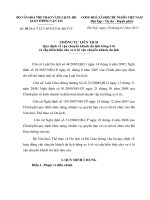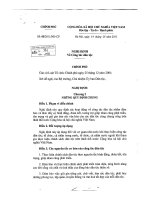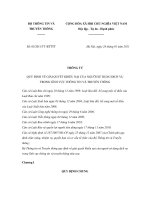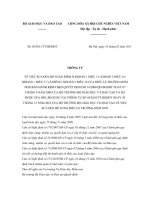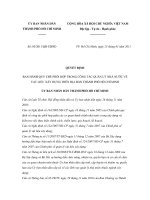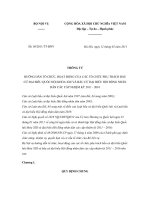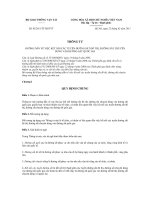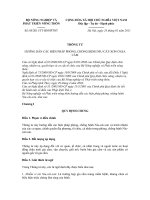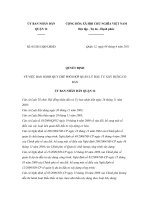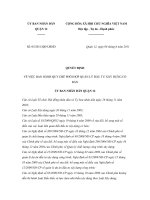E 37 05 (2011)
Bạn đang xem bản rút gọn của tài liệu. Xem và tải ngay bản đầy đủ của tài liệu tại đây (107.81 KB, 6 trang )
Designation: E37 − 05 (Reapproved 2011)
Standard Test Methods for
Chemical Analysis of Pig Lead1
This standard is issued under the fixed designation E37; the number immediately following the designation indicates the year of original
adoption or, in the case of revision, the year of last revision. A number in parentheses indicates the year of last reapproval. A superscript
epsilon (´) indicates an editorial change since the last revision or reapproval.
erations for Chemical Analysis of Metals, Ores, and
Related Materials
E60 Practice for Analysis of Metals, Ores, and Related
Materials by Spectrophotometry
E135 Terminology Relating to Analytical Chemistry for
Metals, Ores, and Related Materials
E173 Practice for Conducting Interlaboratory Studies of
Methods for Chemical Analysis of Metals (Withdrawn
1998)3
E1601 Practice for Conducting an Interlaboratory Study to
Evaluate the Performance of an Analytical Method
1. Scope
1.1 These test methods cover the chemical analysis of pig
lead having chemical compositions within the following limits:
Element
Antimony
Arsenic
Bismuth
Copper
Iron
Lead
Silver
Tin
Zinc
Concentration Range, %
0.001
0.0005
0.002
0.001
0.0005
99.5
0.001
0.001
0.001
to
to
to
to
to
to
to
to
to
0.02
0.02
0.2
0.1
0.005
99.99
0.03
0.02
0.005
1.2 The test methods appear in the following order:
Antimony by the Rhodamine-B Photometric Method
Copper, Bismuth, Silver, and Zinc by the Atomic Absorption
Method
3. Terminology
Sections
21-30
10-20
3.1 For definitions of terms used in this test method, refer to
Terminology E135.
4. Significance and Use
1.3 The values stated in SI units are to be regarded as
standard. No other units of measurement are included in this
standard.
1.4 This standard does not purport to address all of the
safety concerns, if any, associated with its use. It is the
responsibility of the user of this standard to consult and
establish appropriate safety and health practices and determine the applicability of regulatory limitations prior to use.
Specific precautionary statements are given in the individual
test methods.
4.1 These test methods for the chemical analysis of metals
and alloys are primarily intended to test such materials for
compliance with compositional specifications. It is assumed
that all who use these methods will be trained analysts capable
of performing common laboratory procedures skillfully and
safely. It is expected that work will be performed in a properly
equipped laboratory.
5. Apparatus, Reagents, and Photometric Practice
5.1 Apparatus and reagents required for each determination
are listed in separate sections of each test method. The
apparatus, standard solutions, and reagents conform to the
requirements prescribed in Practices E50. Photometers shall
conform to the requirements prescribed in Practice E60.
2. Referenced Documents
2.1 ASTM Standards:2
B29 Specification for Refined Lead
E29 Practice for Using Significant Digits in Test Data to
Determine Conformance with Specifications
E50 Practices for Apparatus, Reagents, and Safety Consid-
6. Safety Hazards
6.1 For precautions to be observed in the use of certain
reagents in these test methods, refer to Practices E50.
1
These test methods are under the jurisdiction of ASTM Committee E01 on
Analytical Chemistry for Metals, Ores, and Related Materials and are the direct
responsibility of Subcommittee E01.05 on Cu, Pb, Zn, Cd, Sn, Be, their Alloys, and
Related Metals.
Current edition approved Feb. 1, 2011. Published March 2011. Originally
approved in 1942. Last previous edition approved in 2005 as E37 – 05. DOI:
10.1520/E0037-05R11.
2
For referenced ASTM standards, visit the ASTM website, www.astm.org, or
contact ASTM Customer Service at For Annual Book of ASTM
Standards volume information, refer to the standard’s Document Summary page on
the ASTM website.
7. Sampling
7.1 For procedures for sampling the material, refer to
Specification B29.
3
The last approved version of this historical standard is referenced on
www.astm.org.
Copyright © ASTM International, 100 Barr Harbor Drive, PO Box C700, West Conshohocken, PA 19428-2959. United States
1
E37 − 05 (2011)
12.1.4 If the minimum response is not achieved, prepare
another dilute standard solution to provide a higher concentration range, and repeat 12.1.2 and 12.1.3. If the calibration curve
does not meet the linearity criterion, prepare another dilute
standard solution to provide a lower concentration range, and
repeat 12.1.2 and 12.1.3. If a concentration range cannot be
found for which both criteria can be met, do not use this
method until the performance of the apparatus has been
improved.
12.1.5 Perform the stability test as directed in 14.1.3. If
either of the minimum stability requirements is not met, do not
use this method until the repeatability of the readings has been
suitably improved.
8. Rounding Calculated Values
8.1 Calculated values shall be rounded to the desired number of places as directed in Practice E29.
9. Interlaboratory Studies
9.1 These test methods have been evaluated in accordance
with Practice E173, unless otherwise noted in the precision
section.
COPPER, BISMUTH, SILVER, AND ZINC BY THE
ATOMIC ABSORPTION METHOD
10. Scope
10.1 This test method covers the determination of bismuth
in concentrations from 0.002 to 0.2 %, copper from 0.001 to
0.1 %, silver from 0.001 to 0.03 %, and zinc from 0.001 to
0.005 %.
13. Interferences
13.1 Elements ordinarily present do not interfere if their
concentrations are under the maximum limits shown in 1.1.
11. Summary of Test Method
11.1 The sample is dissolved in a nitric-perchloric acid
mixture, the solution is fumed, and hydrochloric acid is added
to precipitate lead chloride. The hydrochloric-perchloric acid
solution is aspirated into the air-acetylene flame of an atomic
absorption spectrophotometer. The absorption of the resonance
line energy from the spectrum of each element is measured and
compared with that of calibration solutions of the same
element. The lines used were Cu 324.7, Bi 223.0, Ag 328.0,
and Zn 213.8 nm
14. Apparatus
12. Concentration Range
NOTE 1—Optimum settings for the operating parameters of the atomic
absorption spectrophotometer vary from instrument to instrument.
14.1 Atomic Absorption Spectrophotometer—Use hollowcathode lamps, operated in accordance with manufacturers’
recommendations as sources for the following lines: Cu 324.7,
Bi 223.0, Ag 328.0, and Zn 213.8 nm. Aspirate the solutions
into an air-acetylene flame of a premix burner. Determine that
the atomic absorption spectrophotometer is satisfactory for use
in this method by proceeding as directed in 14.1.1-14.1.3.
12.1 The concentration range for each element must be
determined experimentally because the optimum range will
depend upon the individual instrument. Determine the appropriate concentration range of each element as follows:
12.1.1 Prepare a dilute standard solution as directed in
Section 16. Refer to 16.1 for suggested initial concentrations.
12.1.2 Prepare the instrument for use as directed in 18.1.
Measure the instrument response while aspirating water, the
calibration solution with the lowest concentration, and the two
with the highest concentrations. Determine the minimum
response and the curve linearity as directed in 14.1.1 and
14.1.2, respectively.
12.1.3 If the instrument meets or surpasses the minimum
response and curve linearity criteria, the initial concentration
range may be considered suitable for use. In this case proceed
as directed in 12.1.5.
14.1.1 Minimum Response— Calculate the difference between the readings of the two highest of five equally spaced
(16.2) calibration solutions. This difference must be at least 40
scale units.
NOTE 2—The scale unit is defined as the smallest numerical interval
that is estimated in taking each reading on the instrument. If the scale is
non-linear, the largest unit defined in this manner is used.
14.1.2 Curve Linearity— Calculate the difference between
the scale readings obtained with water and the lowest of the
five equally spaced calibration solutions. If necessary, convert
this difference and the difference calculated in 14.1.1 to
absorbance. Divide the difference for the highest interval by
that for the lowest interval. If this ratio is not 0.70 or greater,
proceed as directed in 12.1.4.
2
E37 − 05 (2011)
concentrations equal to that of the corresponding test solution,
dilute to volume, and mix. Do not use solutions that have stood
more than 24 h.
14.1.3 Minimum Stability—If the variability of the readings
of the highest calibration solution and of water is not less than
1.8 % and 1.4 %, respectively, as calculated below, proceed as
directed in 12.1.5.
100
VC 5
¯
C
Vo 5
where:
VC
C¯
^ (C − X¯)2
VO
¯
O
¯ )2
^(O − O
n
100
¯
C
Œ
Œ( ~
( ~ C 2 C¯ !
17.1 Test Solution:
17.1.1 Transfer a 10 g sample, weighed to the nearest 10
mg, to a 300-mL Erlenmeyer flask (Note 3). Add 3 mL of
HNO3 and 15 mL of HClO4, and heat until dissolution is
complete. Evaporate to strong fumes of perchloric acid and
cool.
(1)
n21
¯!
O2O
n21
17. Procedure
2
2
(2)
= percent variability of the highest calibration
readings,
= average absorbance value for the highest calibration solution,
= sum of the squares of the n differences between the absorbance readings of the highest
calibration solution and their average,
= percent variability of the readings on water
relative to C¯,
= average absorbance value of water,
= sum of the squares of the n difference between
the absorbance readings of water and their
average, and
= number of determinations, three or more.
NOTE 3—Due to the limited solubility of silver chloride, the silver
concentration in the sample solution should be less than 1 mg/100 mL. If
the expected silver concentration is higher than 0.01 %, choose a sample
weight that limits the silver concentration to less than 1 mg/100 mL.
17.1.2 Add 50 mL of water and, while swirling, heat to
boiling. Add 25 mL of HCl. If less than a 10-g sample is used,
add 20 mL HCl plus 0.5 mL for each gram of sample used.
Heat again to boiling and cool to room temperature.
17.1.3 Transfer the solution and precipitate to a 100-mL
volumetric flask, dilute to volume with water, and mix thoroughly. Allow the precipitated lead chloride to settle. Use the
supernatant solution, or dilute an appropriate aliquot of the
supernatant solution to provide a concentration of the element
being measured which lies within the concentration range
determined in Section 12.
15. Reagents
17.2 Reagent Blank Solution—Prepare a reagent blank by
adding 3 mL of HNO3 and 15 mL of HClO4 to a 300-mL
Erlenmeyer flask and proceed as directed in 17.1.
15.1 Bismuth, Standard Solution (1 mL = 1 mg Bi)—
Transfer 1 g of bismuth (purity: 99.9 % min) to a 400-mL
beaker and dissolve in 50 mL of HNO3 (1 + 1), heating gently
if necessary. When dissolution is complete, cool, transfer to a
1-L volumetric flask, add 100 mL of HNO3 (1 + 1), dilute to
volume, and mix. Store in a polyethylene bottle.
18. Measurement
18.1 Instrument Adjustment—Optimize the response of the
instrument as directed in 18.1.1-18.1.4.
18.1.1 Set the instrument parameters approximately at the
values obtained in 14.1, and light the burner.
18.1.2 Adjust the instrument to the approximate wavelength
for the element to be determined, permit the instrument to
reach thermal equilibrium, and complete the wavelength adjustment to obtain maximum absorption while aspirating the
highest calibration solution.
18.1.3 Optimize fuel, air, and burner adjustments while
aspirating the highest calibration solution.
18.1.4 Aspirate water long enough to establish that the
absorbance reading is stable and then set the initial reading
(approximately zero absorbance or 100 % transmittance).
15.2 Copper, Standard Solution (1 mL = 1 mg Cu)—
Proceed as directed in 15.1, but substitute 1 g of copper (purity:
99.9 % min) for the bismuth.
15.3 Silver, Standard Solution (1 mL = 1 mg Ag)—Proceed
as directed in 15.1 but substitute 1 g of silver (purity: 99.9 %
min) for the bismuth.
15.4 Zinc, Standard Solution (1 mL = 0.1 mg Zn)—Proceed
as directed in 15.1 but substitute 0.1 g of zinc (purity: 99.9 %
min) for the bismuth.
16. Calibration
16.1 Dilute Standard Solution—Using pipets, transfer to
500-mL volumetric flasks the following volumes of each
standard solution: bismuth, 20 mL; copper, 10 mL; silver, 5
mL; and zinc, 10 mL. Dilute to volume and mix. Adjust the
concentration of a dilute standard solution if the proper range
is not obtained when the 5, 10, 15, 20, and 25-mL portions are
diluted to 100 mL and tested.
18.2 Photometry:
18.2.1 Aspirate the test solution and note, but do not record
the reading.
NOTE 4—Avoid transferring particles of precipitated lead chloride that
may clog the aspirator during the measurements of the test solution.
18.2.2 Aspirate water until the initial reading is again
obtained. Aspirate the calibration solutions and test solution in
order of increasing instrument response, starting with the
reagent blank. When a stable response is obtained for each
solution, record the reading.
18.2.3 Proceed as directed in 18.2.2 at least twice more.
16.2 Calibration Solutions—Prepare five calibration solutions for each element to be determined. Using pipets, transfer
5, 10, 15, 20, and 25-mL portions of the appropriate dilute
standard solution to 100-mL volumetric flasks. Add sufficient
volumes of HCl and HClO4 to each flask to yield final acid
3
E37 − 05 (2011)
ANTIMONY BY THE RHODAMINE-B
PHOTOMETRIC METHOD
19. Calculations
19.1 Calculate the variability of the readings for water and
the highest calibration solution as directed in 14.1.3 to determine whether they are less than 1.4 % and 1.8 %, respectively.
If they are not, disregard the data, readjust the instrument, and
proceed again as directed in 18.2.
21. Scope
21.1 This test method covers the determination of antimony
in pig lead in concentrations from 0.0008 to 0.005 %.
19.2 If necessary, convert the average of the readings for
each calibration solution to absorbance. Calculate the net
absorbance of the test solution by subtracting the absorbance of
the reagent blank solution.
22. Summary of Test Method
22.1 After nitric acid dissolution of the sample, lead is
separated as the sulfate. Antimony is oxidized with sulfatoceric
acid and extracted into isopropyl ether; rhodamine-B is added
and photometric measurement is made at approximately 550
nm.
19.3 Prepare a calibration curve by plotting the absorbance
values for the calibration solutions against milligrams of the
elements per millilitre.
23. Concentration Range
19.4 Convert the net absorbance value of the test solution to
milligrams of the element per millilitre by means of the
appropriate calibration curve.
23.1 The recommended concentration range is from 0.002
to 0.020 mg of antimony per 20 mL of solution, using a 1-cm
cell.
19.5 Calculate the percentage of the element as follows
(Note 5):
Element, % 5 @ ~ A 3 B 3 0.977! /C # 3 100
NOTE 6—This method has been written for cells having a 1-cm light
path. Cells having other dimensions may be used, provided suitable
adjustments can be made in the amounts of sample and reagents used.
(3)
where:
A = milligrams of element per millilitre,
B = final volume of test solution in millilitres, and
C = milligrams of sample represented in final volume of test
solution.
24. Stability of Color
24.1 Because of the volatility of ether, it is advisable to
make readings promptly.
NOTE 5—The factor 0.977 is used to compensate for the volume error
in the 100 mL of final test solution caused by the 13.1 g of lead chloride
precipitate. If less than 10 g of sample is used, calculate and apply an
appropriate factor.
25. Interferences
20. Precision and Bias
26. Reagents
20.1 Precision—Seven laboratories cooperated in testing
this method, with one laboratory reporting a second pair of
values; the data are summarized in Table 1.
26.1 Antimony, Standard Solution A (1 mL = 0.1 mg Sb)—
Dissolve 0.100 g of antimony (purity: 99.8 % min) in 1 mL of
HNO3 and 20 mL of H2SO4. Heat until dissolution is complete
and then fume for 5 min. Cool, dilute carefully to about 200
mL, and transfer to a 1-L volumetric flask. Cool, dilute to
volume, and mix.
25.1 Elements ordinarily present do not interfere if their
concentrations are under the maximum limits shown in 1.1.
20.2 Bias—The accuracy of this method could not be
evaluated because adequate certified reference materials were
unavailable at the time of testing. The user is cautioned to
verify by the use of certified reference materials, if available,
that the accuracy of this method is adequate for the contemplated use.
26.2 Antimony, Standard Solution B (1 mL = 0.005 mg
Sb)— Using a pipet, transfer 10 mL of Solution A (1 mL = 0.1
mg Sb) to a 200-mL volumetric flask. Add 5 mL of H2SO4 .
Cool, dilute to volume, and mix.
20.3 Practice E173 has been replaced by Practice E1601.
The Reproducibility Index R2 of Practice E173 corresponds to
the Reproducibility Index R of Practice E1601. Likewise the
Repeatability Index R1 of Practice E173 corresponds to the
Repeatability Index r of Practice E1601.
26.3 Isopropyl Ether, Washed—Transfer 500 mL of isopropyl ether to a 1-L separatory funnel. Add 200 mL of HCl and
shake for 1 min. (Take care to avoid pressure build-up.) Add
200 mL of water and shake for 30 s. Allow the phases to
separate and discard the aqueous phase. Wash the organic
phase with 200 mL of water, and shake for 30 s. Allow the
phases to separate and discard the aqueous phase. Repeat one
more time. Do not use the reagent if it has stood more than 24
h.
TABLE 1 Statistical Information
Test Specimen
Bi
B-2
A-2
Cu B-2
A-2
Ag B-2
A-2
Zn C-1
D-1
Element Found, %
Repeatability
(R1, E173)
Reproducibility
(R2, E173)
0.0024
0.223
0.0014
0.112
0.0010
0.0308
0.0001
0.0021
0.0010
0.016
0.0002
0.010
0.0002
0.0052
0.0004
0.0003
0.0010
0.021
0.0002
0.012
0.0002
0.0052
0.0004
0.0009
26.4 Rhodamine-B Solution (0.1 g/L in 0.5 M HCl)—
Dissolve 50 mg of rhodamine-B in water. Add 22 mL of HCl
and dilute to 500 mL.
26.5 Sulfatoceric Acid Solution (2.0 g/L)—Dissolve 200 mg
of sulfatoceric acid (H4Ce(SO4)4) in water. Add 3 mL of
H2SO4 (1 + 1) and dilute to 100 mL.
4
E37 − 05 (2011)
27. Preparation of Calibration Curve
NOTE 7—If concentrations greater than 0.005 % are encountered, a
correspondingly larger volumetric flask or a smaller aliquot portion should
be used.
27.1 Calibration Solutions—Using pipets, transfer 1, 2, 3, 4,
and 5 mL of Solution B (1 mL = 0.005 mg Sb) to 250-mL
beakers. Add 1 mL of H2SO4 and evaporate to dryness, but do
not bake. Proceed as directed in 27.4.
28.1.3 Evaporate the filtrate or the aliquot to dryness, but do
not bake. Remove from the heat and cool to room temperature.
Proceed as directed in 27.4.
27.2 Reference Solution—Isopropyl ether, washed.
28.2 Reagent Blank—Carry a reagent blank through the
entire procedure using the same amount of all reagents with the
sample omitted.
27.3 Reagent Blank— Transfer 1 mL of H2SO4 to a 250-mL
beaker and evaporate to dryness, but do not bake. Proceed as
directed in 33.4.
28.3 Reference Solution—Isopropyl ether, washed.
27.4 Color Development:
27.4.1 Add 10 mL of HCl and swirl to dissolve the residue.
Transfer to a 125-mL separatory funnel. Rinse the beaker with
7 mL of HCl and add the rinsings to the separatory funnel.
Using a pipet, add 1 mL of sulfatoceric acid solution and mix.
Using a pipet, add 20 mL of the washed isopropyl ether. Shake
for approximately 30 s, releasing the pressure periodically.
27.4.2 To the original beaker, add 6 mL of water, swirl, and
transfer to the separatory funnel. Repeat one more time. Shake
for approximately 30 s and allow to cool to room temperature.
27.4.3 Shake for another 30 s. Allow the phases to separate
and discard the lower (aqueous) phase. Add 20 mL of
rhodamine-B solution and shake for approximately 30 s. Allow
the phases to separate and discard the lower phase.
27.4.4 Draw off the ether phase into a dry, stoppered test
tube and allow to settle for approximately 30 s before transferring to the absorption cell.
28.4 Color Development—Proceed as directed in 27.4.
28.5 Photometry—Take the photometric readings of the
reagent blank and test solutions as directed in 27.5.
29. Calculation
29.1 Convert the net photometric readings of the test and
reagent blank solutions to milligrams of antimony by means of
the calibration curve. Calculate the percent of antimony as
follows:
Antimony, % 5 ~ A 2 B ! / ~ C 3 10!
(4)
where:
A
= milligrams of antimony found in 20 mL of the final
test solution,
B
= milligrams of antimony found in 20 mL of final
reagent blank solution, and
C
= grams of sample represented in 20 mL of the final test
solution.
27.5 Photometry:
27.5.1 Multiple-Cell Photometer—Measure the cell correction using absorption cells with a 1-cm light path and a light
band centered at approximately 550 nm. Using the test cell,
take the photometric readings of the calibration and reagent
blank solutions.
27.5.2 Single-Cell Photometer—Transfer a suitable portion
of the reference solution to an absorption cell with a 1-cm light
path and adjust the photometer to the initial setting, using a
light band centered at approximately 550 nm. While maintaining this adjustment, take photometric readings of the calibration and reagent blank solutions.
30. Precision and Bias
30.1 Precision—Data on this test method were obtained by
six laboratories, with two laboratories providing a second pair
of values. The data are summarized in Table 2.
30.2 Bias—The accuracy of this test method could not be
evaluated because adequate certified reference materials were
unavailable at the time of testing. The user is cautioned to
verify by the use of certified reference materials, if available,
that the accuracy of this method is adequate for the contemplated use.
27.6 Calibration Curve—Plot the net photometric readings
of the calibration solutions against milligrams of antimony per
20 mL of solution.
30.3 Practice E173 has been replaced by Practice E1601.
The Reproducibility Index R2 of Practice E173 corresponds to
the Reproducibility Index R of Practice E1601. Likewise the
Repeatability Index R1 of Practice E173 corresponds to the
Repeatability Index r of Practice E1601.
28. Procedure
28.1 Test Solution:
28.1.1 Transfer a 1 g sample, weighed to the nearest 1 mg,
to a 250-mL beaker. Add 10 mL of HNO3 (1 + 2) and heat
gently until dissolution is complete. Add 5 mL of H2SO4
(1 + 1), dilute to 30 mL, mix thoroughly, and cool to room
temperature. Filter through an 11-cm coarse paper into a
250-mL beaker. Wash the precipitate with three 5-mL portions
of cold water. Discard the precipitate.
28.1.2 For antimony concentrations from 0.0008 to
0.002 %, use the entire filtrate for color development. For
antimony concentrations from 0.002 to 0.005 %, transfer the
filtrate to a 100-mL volumetric flask, dilute to volume, and mix
(Note 7). Using a pipet, transfer 40 mL to a 250-mL beaker.
31. Keywords
31.1 antimony; atomic absorption; bismuth; colorimetry;
copper; lead; silver; zinc
TABLE 2 Statistical Information
5
Test Specimen
Element Found, %
1
2
0.0008
0.0045
Repeatability
(R1, E173)
0.0002
0.0003
Reproducibility
(R2, E173)
0.0002
0.0007
E37 − 05 (2011)
ASTM International takes no position respecting the validity of any patent rights asserted in connection with any item mentioned
in this standard. Users of this standard are expressly advised that determination of the validity of any such patent rights, and the risk
of infringement of such rights, are entirely their own responsibility.
This standard is subject to revision at any time by the responsible technical committee and must be reviewed every five years and
if not revised, either reapproved or withdrawn. Your comments are invited either for revision of this standard or for additional standards
and should be addressed to ASTM International Headquarters. Your comments will receive careful consideration at a meeting of the
responsible technical committee, which you may attend. If you feel that your comments have not received a fair hearing you should
make your views known to the ASTM Committee on Standards, at the address shown below.
This standard is copyrighted by ASTM International, 100 Barr Harbor Drive, PO Box C700, West Conshohocken, PA 19428-2959,
United States. Individual reprints (single or multiple copies) of this standard may be obtained by contacting ASTM at the above
address or at 610-832-9585 (phone), 610-832-9555 (fax), or (e-mail); or through the ASTM website
(www.astm.org). Permission rights to photocopy the standard may also be secured from the ASTM website (www.astm.org/
COPYRIGHT/).
6
